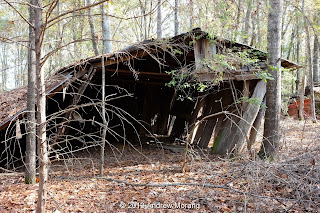Country stores once abounded in rural Mississippi. In an era before everyone owned their own car, rural people walked or rode a carriage to the country store to buy seed, tools, groceries, books, a newspaper, candies, or to make a telephone call. In 2011, I wrote about the
Betigheimer store on Hwy 27, long gone. This one is near Utica: the W.B. Yates store, at the junction of Old Port Gibson and Cayuga Roads.
 |
| W.B. Yates store, Old Port Gibson Road |
This is a rather basic cinder-block structure with the squared-off front that is so common on stores and commercial buildings in early-20th century rural areas. The grey paint makes the place more severe, but the
Coca-Cola sign adds a splash of red.
I could not go inside, and all the windows were blocked with plywood.
While I was putting my tripod away, an elderly gent came by to talk. He was a relative of the Yates family. He said the present store was built in 1947 (that explains the post-war cinder blocks). The original store was across the street where a post-war suburban home now sits. Mr. Yates died in 1986 and Mrs. Yates operated the store for two more years. She died tragically when she was hit by an 18-wheeler.
The name Cayuga, as in Cayuga Road, is an Indian name. The European settlers to this area came from upstate New York, where Cayuga Lake is the longest of the glacial-derived Finger Lakes. This is different than Cuyahoga, which is the name of the river that flows through Cleveland and debouches into Lake Erie.
The gent had some other interesting stories. Nearby is Charlie Brown Road. People kept stealing the sign, and the highway department could not figure out why. He convinced them to print a sign "C Brown," and the theft problem ended.
These are digital images from a Panasonic G3 digital camera and a 1949-vintage Leica 5cm ƒ/2.0 Summitar lens, tripod-mounted. My father bought the Summitar and its accompanying Leica IIIC rangefinder camera new at the Post Exchange on Guam. Stopped down to ƒ/4.0 or so, this lens equals many contemporary optics.
Update December 2019: A cabinet-maker and carpenter is using the Yates store. We chatted for a few minutes, and he said he was very busy with projects. Good news!
 |
| W.B. Yates Store (Panatomic-X film, Hasselblad 501CM camera, 80mm ƒ/2.8 Planar-CB lens, yellow filter) |








































